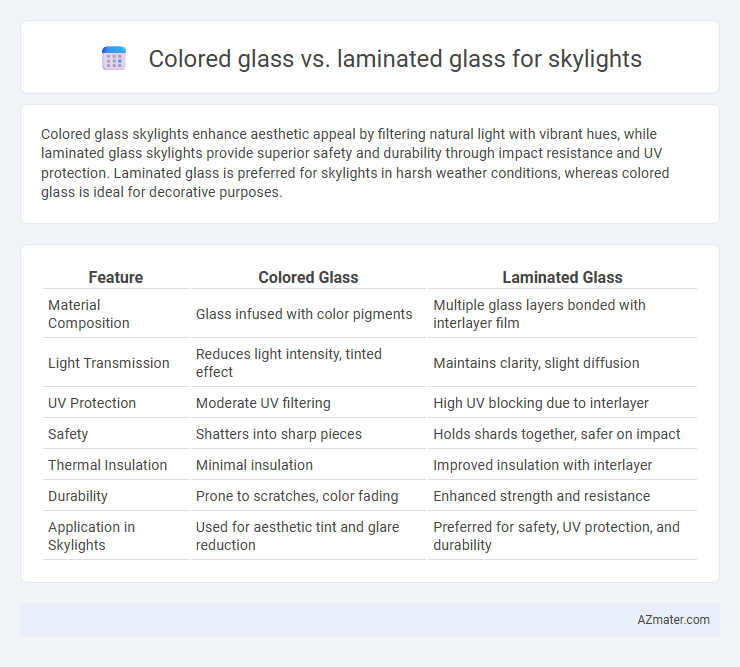Colored glass skylights enhance aesthetic appeal by filtering natural light with vibrant hues, while laminated glass skylights provide superior safety and durability through impact resistance and UV protection. Laminated glass is preferred for skylights in harsh weather conditions, whereas colored glass is ideal for decorative purposes.
Table of Comparison
| Feature | Colored Glass | Laminated Glass |
|---|---|---|
| Material Composition | Glass infused with color pigments | Multiple glass layers bonded with interlayer film |
| Light Transmission | Reduces light intensity, tinted effect | Maintains clarity, slight diffusion |
| UV Protection | Moderate UV filtering | High UV blocking due to interlayer |
| Safety | Shatters into sharp pieces | Holds shards together, safer on impact |
| Thermal Insulation | Minimal insulation | Improved insulation with interlayer |
| Durability | Prone to scratches, color fading | Enhanced strength and resistance |
| Application in Skylights | Used for aesthetic tint and glare reduction | Preferred for safety, UV protection, and durability |
Introduction to Skylight Glazing Options
Skylight glazing options primarily include colored glass and laminated glass, each offering distinct benefits for natural light control and safety. Colored glass enhances aesthetic appeal and reduces glare by filtering sunlight, while laminated glass provides superior impact resistance and UV protection, improving durability and occupant safety. Selecting the right glazing depends on balancing design preferences with functional needs such as energy efficiency and security.
What is Colored Glass?
Colored glass for skylights is glass infused with metal oxides or heat-applied color coatings that alter its appearance and light transmission properties. It reduces glare and solar heat gain while enhancing aesthetic appeal by tinting the natural light entering a space. Unlike laminated glass, which incorporates a plastic interlayer for added strength and safety, colored glass primarily focuses on visual and thermal performance.
What is Laminated Glass?
Laminated glass consists of two or more glass layers bonded together with an interlayer, typically made of polyvinyl butyral (PVB), providing enhanced strength and safety for skylights. This structure prevents shattering upon impact, reducing the risk of injury and maintaining structural integrity during harsh weather conditions. Laminated glass also offers superior sound insulation and UV protection compared to colored glass, making it a functional and durable choice for skylight applications.
Aesthetic Impact: Colored Glass vs Laminated Glass
Colored glass skylights provide vibrant hues that dramatically alter natural light, creating a striking visual ambiance tailored to interior design themes. Laminated glass skylights enhance aesthetic appeal by offering clarity and safety without compromising transparency, often incorporating subtle tints or patterns for a refined look. Both materials influence mood and design, with colored glass introducing bold artistic statements and laminated glass delivering understated elegance and durability.
Natural Light Transmission Comparison
Colored glass skylights reduce natural light transmission by filtering sunlight through tinted layers, resulting in diminished brightness and altered color perception indoors. Laminated glass maintains higher natural light transmission while enhancing safety and UV protection due to its interlayer, preserving clear and consistent daylight flow. Choosing laminated glass for skylights ensures optimal illumination with added durability, whereas colored glass prioritizes aesthetic tinting at the expense of reduced natural light.
UV Protection and Energy Efficiency
Colored glass skylights reduce UV radiation by filtering sunlight through tinted layers, minimizing interior fading and heat buildup. Laminated glass features a PVB interlayer that effectively blocks up to 99% of harmful UV rays while enhancing safety and structural integrity. Energy efficiency improves with laminated glass by reducing solar heat gain, whereas colored glass offers moderate thermal insulation based on tint intensity.
Safety and Durability Factors
Colored glass for skylights offers enhanced UV protection and aesthetic appeal, but may be prone to cracking under extreme temperature changes. Laminated glass provides superior safety by holding shards together upon impact, reducing the risk of injury, and demonstrates higher durability against weathering and mechanical stress. For optimal safety and long-term performance in skylight applications, laminated glass is often the preferred choice due to its impact resistance and structural integrity.
Noise Reduction Capabilities
Laminated glass offers superior noise reduction capabilities for skylights compared to colored glass due to its interlayer that dampens sound vibrations. Colored glass primarily focuses on aesthetic and light-filtering properties without significantly impacting sound insulation. For effective noise control in skylights, laminated glass with acoustic interlayers is the optimal choice.
Installation and Maintenance Considerations
Colored glass for skylights requires careful handling during installation to preserve its pigmentation integrity, often demanding specialized tools and skilled labor to avoid damage. Laminated glass offers enhanced safety and durability, simplifying maintenance as its interlayer holds shards in place if broken, reducing replacement frequency. While colored glass may need frequent cleaning to prevent color fading from UV exposure, laminated glass benefits from easier upkeep due to its resistance to impact and weather-related wear.
Cost Analysis: Colored vs Laminated Glass for Skylights
Colored glass for skylights typically costs less upfront due to simpler manufacturing processes but may lead to higher long-term expenses from fading and heat retention effects. Laminated glass involves higher initial investment because of its multi-layer construction and safety features, yet it offers enhanced durability, UV protection, and energy efficiency that reduce maintenance and replacement costs over time. Choosing laminated glass often results in better value when considering total cost of ownership and performance benefits for skylight applications.

Infographic: Colored glass vs Laminated glass for Skylight
 azmater.com
azmater.com